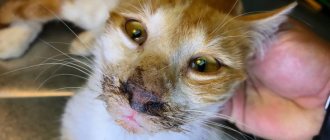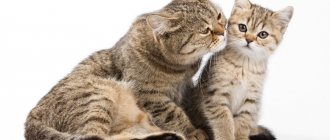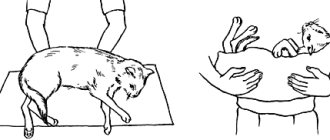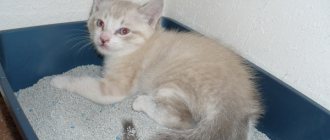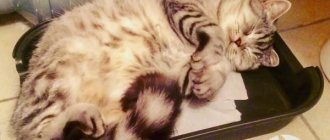More familiar smells
Please believe the experience of the author of these lines: the behavior of pets, primarily cats, changes after moving. Sometimes even radical! We understand that in the hustle and bustle, when things are unloaded, it is incredibly difficult to keep track of the cat. And yet, make a note in your memory: the main focus is on your pet(s). If possible, release your cat into the new house or apartment after most of the things have been brought in and arranged. The abundance of familiar smells will certainly alleviate the first stress. And yet, you may not recognize your pet at all. Anything can happen: a previously calm, leisurely cat bristles, rears up, or tries to escape. The sociable animal hides in the farthest corner and does not appear from there for weeks. Something worse also happens: behavioral disorders, increased vocalization, cats refuse to use the litter box and do their business anywhere. Special attention to those who have two or more pets. When moving to a new place, the hierarchy established between them often collapses, wars for leadership flare up with renewed vigor and are often accompanied by fierce fights.
Of course, it is not at all necessary that everything will go according to the pessimistic scenario. Just forewarned means forearmed. The main thing is to minimize the initial stress by surrounding the animal with familiar smells!
The most common stressors
The owner’s task is to protect the animal from stress. Each owner knows the character of his pet and understands which events or actions will cause him psychological discomfort, and which he will survive calmly. Thus, some breeds are quite loyal to water and even love bathing, while for others the washing procedure is a real stress and shock.
They are forced to adapt to the owner’s lifestyle, and they prefer to follow the rules learned from childhood. Orderliness is the basis of a cat’s life; they do not like surprises and changes. Anything that disrupts the usual course of life is quite difficult for these animals mentally.
The strength of the nervous system varies among all breeds. They also differ in temperament. Cats can also be divided into sanguine (they tolerate stressful situations quite easily), choleric (they can cope with stress quickly), phlegmatic (they prefer not to show emotions) and melancholic (they experience stress the hardest).
Various reasons can lead to stress. They can be divided into external and internal (physiological and psychological).
External influences
External influences are the most common group of causes of stress in cats. Any changes in their daily routine cause discomfort to these animals.
The level of stress may vary, but any external influences that are “not included in the plans” of the cat make it worry.
Negative external influences include the following.
A trip to the veterinary clinic
Leaving a habitable and recognized safe territory is already stressful. She is put in a carrier and forcibly taken out of her comfort zone. Not everyone handles travel well, so for many of them this is another reason to worry. Then the cat finds herself in an unfamiliar room filled with strange, sometimes very irritating odors, and strangers begin to touch her.
If procedures are necessary, and even unpleasant ones, then the animal generally begins to experience real panic. Some owners notice that after visiting the veterinarian, the cat's hair begins to fall out. This is the same common reaction to stress as in humans.
Visiting the cat groomer
Here the order is the same as in the previous case. Plus, unpleasant procedures are guaranteed. If an animal visits a “cat stylist” from an early age, it can tolerate his manipulations quite easily.
If the cat is unaccustomed to haircuts, washing and other procedures, then they will become a source of very strong stress for her.
Departure of the owner, foster care
Many owners do not have the opportunity to take their pet with them, for example, on a business trip or on vacation. Some simply do not want to expose the animal to stress, especially if it suffers from seasickness and does not tolerate travel in public transport. Then, if it is necessary to leave, it is given to friends, relatives or people who professionally care for animals.
The latter are the most preferable solution, since such people find out the pet’s habits and routine and try to provide her with the most comfortable conditions. In any case, a change of place, new smells, a change in the usual daily routine is stressful for a cat. In addition, she does not understand that this is temporary, and may have a hard time worrying about it.
The arrival of a new family member or pet
Cats, like people, can be jealous and feel that they are not getting enough attention. The birth of a child is easier for her to bear, but finding methods of communication with another animal is much more difficult.
If this is a baby, then the cat or cat can take “patronage” over him. When he becomes an adult, conflicts may occur. In any case, the appearance of a new character on the territory that the pet considers its own, habitable, plunges the animal into a stressful state.
Repair
This is a real hell for a cat: sharp sounds, smells, changes in the environment (for the sake of the animal’s safety, everything needs to be controlled), constant fuss. If workers are hired, this is also a source of stress, because most breeds are wary of strangers.
The daily routine changes, and the owner may forget to fill the bowl because he is too busy. There may also not be enough time and energy for the communication that a cat is accustomed to.
Some owners, trying to protect the animal from stress and remove dirt and dust, lock it in another room. This can also cause psychological trauma to it: after all, it does not understand the source of sharp sounds and cannot control what is happening behind the door.
Holidays, parties, arrival of guests
The sensations are approximately the same as during repairs, only the horror ends faster. Cats are suspicious of new people with unfamiliar smells.
If they also try to communicate with the animal (especially if it doesn’t like “strangers”), then they’re basically on guard.
Firecrackers exploding outside the windows, causing severe fear, and changes in the daily routine can add “sharpness” to the New Year’s holiday. The owner's consumption of alcohol can cause bewilderment in the animal: the smell, facial expressions and behavior of familiar and loved ones change. From a cat's point of view, these are all reasons for negative emotions.
Moving, change of residence
This is the biggest stress for cats. Despite the fact that they become attached to people, they are no less attached to a place. This is due to the fact that she considers the inhabited and fully surveyed territory to be more or less safe. From her wild ancestors she inherited instincts that force her to control what is happening around her for her own safety.
New territory means the need to survive at any cost. Therefore, many owners note that it is impossible to find a cat in a new home at first.
Sometimes they hide for several days until severe hunger forces them to leave their shelter. And even then, having left the shelter, the cat moves around the new house very carefully, in short dashes, constantly returning to the shelter.
Familiar things can help you get comfortable in a new place: a house or bedding, toys.
Diseases and physiological causes
If a cat is sick, this immediately affects its emotional state. Any problems in the body make this predator feel vulnerable. The stronger the symptoms of the disease, the higher the stress level.
They experience minor discomfort more easily than severe pain or other intense manifestations of the disease.
The most common and serious physiological stress factor is parasitic infestations. Infection with helminths causes indigestion, deficiency of nutrients and vitamins, and an increase in symptoms of intoxication. If fleas, subcutaneous parasites appear, or she catches a tick, she experiences itching, pain, discomfort, and in some cases, severe weakness. In such a situation, the cat experiences irritation from itchy skin and weakness. In addition, mites can cause serious infections.
Infection with lice and fungal diseases also causes significant discomfort. The feeling of one’s own weakness deprives one of confidence in safety and the ability to fight for one’s life.
This condition causes deep emotional experiences in the animal.
Pain, both acute and aching, causes no less stress in the cat. Its cause may be:
- injuries;
- surgery or invasive medical procedures;
- unsuccessful mating.
More strange behavior
Some “weirdness” is not a deviation from the norm - it is nature. The cat has found itself in unfamiliar territory, where everything is “foreign.” It is necessary to examine every corner and apply your own scent. In a word, “mark” the territory. Do not prevent a cat that is carefully exploring the house from rubbing its back or face against some objects or things. Don’t be surprised when your pet suddenly craves love and affection - it will spin around you, get under your feet, and “butt” its face. In fact, this is how a defensive psychological reaction works: the animal is nervous, huddles close to its owners, as if waiting for confirmation: nothing terrible has happened, everyone is alive and well, safe. Be sure to caress and stroke the cat at such a difficult moment!
Mr. Cat recommends: methods to help with stress
If your cat is stressed, the first step is to find and, if possible, eliminate the cause. Of course, some factors cannot be corrected, but it is quite possible to alleviate the condition, and the task of a caring owner is to help his pet.
In order to somehow mitigate the situation and neutralize the impact of stress factors, both psychological support methods and drug treatment can be used.
Psychological help
First of all, you need to try to help your pet psychologically. It is impossible for the sake of a cat to return to an old, already sold apartment, much less to revive a deceased owner. However, it is still possible to make the animal’s life easier.
Domestic cats, like people, need manifestations of love; they need to feel not only care, but also warmth and affection. For a pet, such manifestations are tactile contacts with a person. Not all of them like to sit in their arms, but if the animal prefers to spend its time in the arms of a person, then you need to provide it with this pleasure in full. Even those who don’t like to sit on their owner sometimes want to sit next to them and want to be petted.
For a cat, this is both a physiological benefit, massage, and emotional pleasure.
Pets, of course, are not able to communicate verbally with humans, but it is no coincidence that these animals have a wide range of vocal signals. By making various sounds, they “talk” to a person, and they also need to be spoken to. Precisely with the voice. Of course, they don’t understand words, but they feel intonation perfectly. Therefore, it is necessary to express your love and tenderness for the cat with your voice, talking to it.
If your pet loves to play, she must be constantly provided with toys.
Most pets love a treat, and owners should pamper their animals more often if they are under stress. This way you can smooth out the situation and distract from your worries.
During necessary but unpleasant procedures, you need to reassure and support her: both tactilely, so that she feels supported, and with your voice.
Medication methods
If psychological assistance measures are insufficient, then you can try to help the animal with medication. Before giving any medications, your cat should be taken to a veterinarian and examined.
Today there is a large selection of stress relief products available for cats. To rid your animal of emotional problems, you can try various preparations with pheromones (these substances have a calming effect on the animal). They are available in the form of sprays, fumigators, and there are also special collars.
Catnip is sold in pet stores; this herb is also good for fighting negative emotions. It causes a surge of excitement, after which the cat calms down.
Giving tincture of valerian root to an animal for the same purposes is strictly not recommended.
In some cases, when your pet's stress and anxiety levels are very high, your veterinarian may prescribe human antidepressants.
This should be done exclusively by a specialist; he will be able to correctly calculate the dosage for a particular cat. Under no circumstances should you give antidepressant tablets on your own.
To calm and relax your pet, you can try aromatherapy. This method helps both people and animals, whose sense of smell is much better developed.
It is necessary to use essential oils and substances (in aroma lamps or in the form of special sticks) that have a sedative effect (lavender, neroli, ylang-ylang, bergamot, mint, cedar).
To prevent stress, you can use drugs that have a cumulative effect. If you know in advance about a trip to the veterinarian, hairdresser, moving, or other events that cause negative emotions in your pet, then you can prepare the animal by starting to give it sedatives ahead of time. In this case, he will cope with a stressful situation much easier.
The cat is “kneading the dough” again
And very active! Meows, jumps on your lap, purrs, sitting on your lap. Moreover, he “kneads the dough”, which has not been observed for a long time. What is this – an expression of joy from moving? No - this is also a defensive reaction. “Kneading dough” is a behavior inherited by the kitten from distant childhood, when he was close to his mother. The cat is now looking for your sympathy and consolation. We see no reason to refuse an animal such a request! Just “spread some straws” - put on a thick tracksuit or something like that. Your knees shouldn't suffer!
Helping your cat survive the stress of moving
Contents hide
Moving is always a revolution, and on top of that it’s also stressful. Cats worry even more than people, because they love stability, order and peace so much. There are often cases when cats flatly refuse to move, and you have to return to the old apartment and literally drag them by force. Are there any tricks for this?
Make sure that all the “old” smells from your previous home come with you and are placed both inside and outside your new home. Many animals immediately after moving begin to develop various behavioral problems, the animal becomes nervous and restless. This happens especially often when people arrive in a completely new environment (with new furniture and household items). On the contrary, in our case it is important that as many things as possible are moved that your cat knows and is accustomed to. Do not be alarmed if at first the cat hides in some distant corner and sits there. Don't disturb your pet - just give him time to get used to it. If you have two or more cats, then upon arrival at a new apartment, “hierarchical” wars may break out with renewed vigor between them. Everything can be healed with time, peace and stability!
Oddities in behavior can be explained by ordinary reinsurance. Cats are very territorial creatures. Wherever they are, they assert their rights everywhere and to everything. Including their own owners, especially if they are very close and friendly with them. So you can watch how cats in your new apartment will come up to you at the first opportunity and rub against you, including their cute little faces. In fact, there is no strangeness - the cat starts life in a new place “with a clean slate”, checks that its owners are here and still love it. He convinces himself that, in essence, nothing terrible happened. Reasserts herself in the role of “housekeeper”.
The cat may begin to “knead the dough.” Actually, cats “knead” quite often; they have been doing this since early childhood. Then, over time, “kneading dough” turns into an element of affection, which is also not used very often. Immediately after moving, don't forget to wear thick pants, especially if your cat likes to sit on your lap! This “childish” habit can flare up with renewed vigor. In our case, rather, the cat is seeking protection and consolation from you in this way. Don't disappoint her expectations, please!
Your cat may require more food than usual. Again, due to stress, for the sake of reinsurance (and maybe even for future use?), the cat may require feeding more often. You shouldn't immediately think that something is wrong. Let's give one simple tip: take a bowl, fill it to the top with your favorite food and leave it. The cat will return to her as needed and will not annoy you. Over time, everything will return to normal.
At first, keep the cat indoors, despite their protests. Of course, the least problematic would be moving in the winter, when it’s cold outside. Cats are known for their love of warmth! And so, especially in the first weeks, try not to let your pet go outside. At this time, he must completely get comfortable in the new home, absorb all its smells, and feel like family. Of course, this is very difficult (especially for cats leading a “mixed” lifestyle). Cats will die of boredom. But it's worth it - otherwise you risk losing your pet forever.
Your pet may need to be trained to use the litter box again. First of all, we mean the cats described in the previous chapter - our forced “captives”. The difficulty is that these are no longer kittens, but adult animals, and also under stress. It will be incredibly difficult to “convince” them to start using the litter box; it is likely that they will start doing their business in the most inappropriate places. Experts call this behavior a unique form of protest. As in previous cases, everything is healed by time, the owner's love, attention and a lot of affection.
The cat will persistently ask to go outside. So persistently that the rug lying by the door can be torn to shreds. The door itself, furniture in the hallway, etc. may be seriously damaged. What do you recommend? Identify areas that have suffered from cat aggression. They will either have to be additionally protected, or resort to cunning. Cats really don't like sticky surfaces. Buy double-sided tape and stick it on the “problem” areas. In this simple way, your belongings can be protected.
We will be sincerely glad if our advice is useful to you. Support your pet during difficult times, don’t impose anything, don’t force it, let everything flow naturally! Doctor time is on your side. And, of course, your care, attention, and affection. And any problems can be overcome.
Original post: Strange Cat Behavior After Moving Home – Should You Worry? Source and photo:
Contents indoors
Keep your pet indoors for the first week or two. Our recommendations mainly apply to those cats that were previously in mixed housing: walked outside, fed and rested at home. In a new place there is an extremely high risk that the cat will try to escape! That’s why we always advise litter training all animals, without exception, even “street” animals. These skills would come in handy now! However, we remember: at first we are only at home. Then you can very carefully accustom your pet to the street. Another skill you may need to learn is walking your cat on a leash.
Take care of furniture, curtains and carpets
You also need to keep this scenario in mind! A cat will tear curtains and scratch carpets if you keep it indoors and do not let it outside. Whatever one may say, this is a defensive reaction! We warned you that you risk not recognizing your furry friend!
How to deal with the problem? Arm yourself with double-sided tape for carpets. Cats hate sticky surfaces and avoid them at all costs. Having noticed that the cat is “not indifferent” to the curtains, think about how you can save them. Either remove them completely or fasten them - it’s more visible in place. Do not indulge the cat's whims: if you release the animal, you risk never seeing it again! Just a week or two of patience, and life in your (new!) home will flow as usual.
Photo: pets4homes.co.uk
Signs of stress
Cats are secretive animals; they really don’t like to show their weakness. Recognizing that an animal is under stress is not easy. Very often the clinical picture is blurry. But it is necessary to know the symptoms, because the sooner stress is identified and measures taken, the better for the animal.
Acute stress condition
When a cat is affected by negative factors, most often external, a stress hormone is released in the body. This is manifested by some physiological reactions.
- shallow breathing with shorter phases;
- increased heart rate;
- tremor of the limbs, head, whole body;
- excessive salivation;
- various sounds (the range is wide: in case of pain - a guttural meow or howl, in case of fear - a hissing or growl, just constant meowing as a way to “tell” about the problem);
- involuntary emptying of the bladder or bowel;
- external signs: dilated pupils, ears pressed to the head, tail twitching, frightening grin (showing teeth), raised fur, arched back, head lowered below body level.
When a cat is stressed, it may attack, bite and scratch if it feels its life is in danger. In such situations, the symptoms go away on their own once the provoking factor is eliminated.
It is quite simple to recognize signs of fear, excessive anxiety, and extreme dissatisfaction with what is happening based on such signs. It is more difficult if the cat is in a state of permanent stress.
Chronic stress
Being in a state of chronic stress manifests itself more in changes in behavior patterns and disruption of established rituals. Symptoms of a prolonged depressed or tense emotional state include:
- tendency to hide in secluded, inaccessible places;
- changes in eating behavior: lack of appetite or uncontrolled gluttony followed by vomiting;
- fanatical licking or loss of interest in self-care;
- performing natural needs in inappropriate places, ignoring the cat litter box (sometimes cats defiantly sit down to do their business directly next to the litter box);
- digestive disorders: vomiting, lack of bowel movements, change in the nature of bowel movements;
- lethargy, lack of desire to play, run, constantly staying in some place, prolonged sleep (you must understand that most cats, even in a healthy state, sleep most of the day);
- even with a slight change in noise level, lighting, or sudden sharp sounds, it can react extremely inadequately;
- leaving marks, splashing urine;
- nervous reactions in the form of scratching the skin until it bleeds, hair loss, the appearance of bald spots and scratches on the body;
- contradictory behavior: the cat cannot calm down, then lies down, then sits down, suddenly changes direction when moving, and the like.
